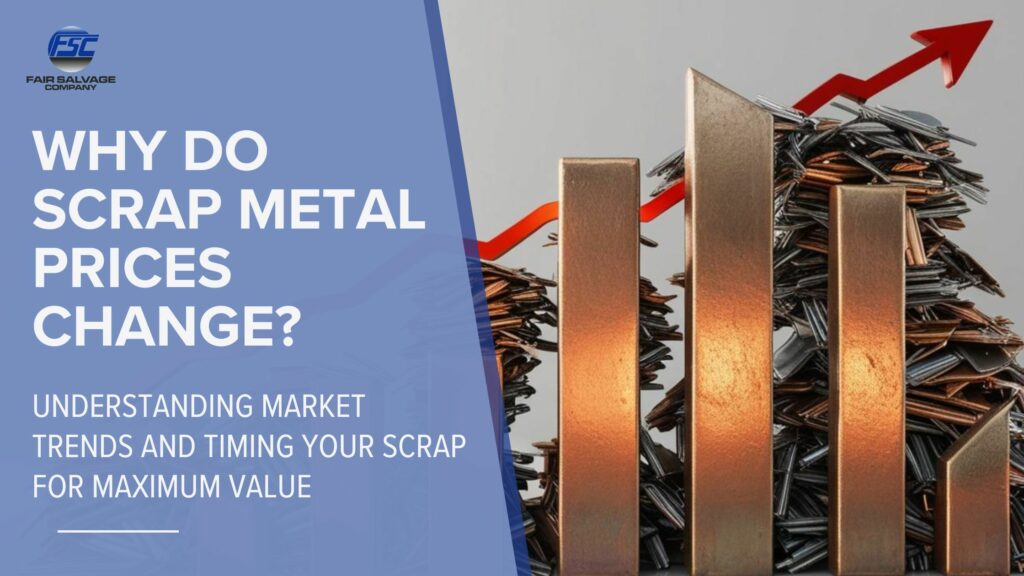Why Scrap Metal Prices Change and Fluctuate—and How to Stay Ahead
One of the most common questions we hear at Fair Salvage Company is:
“Why do scrap metal prices change so much?”
It’s a fair question—and one that matters whether you’re a contractor with demolition scrap, a farmer clearing out old equipment, or a manufacturer looking to maximize returns on metal waste.
The truth is, scrap prices are tied to a global web of market forces. Some are predictable. Others—like shipping disruptions or currency shifts—come out of nowhere.
In this article, we’ll break down the key drivers of scrap metal pricing, share real-world insight from our team, and help you make smarter decisions about when to sell. As always, Fair Salvage is here to guide you every step of the way.
What Causes Scrap Metal Prices to Change?
If you’ve ever checked our daily updated pricing page and noticed the numbers shift from week to week, you’re not imagining things. Scrap metal prices are influenced by a mix of global, national, and local factors.
Here are four of the most significant ones:
1. Tariffs and Trade Policy
International tariffs and trade deals can instantly impact metal pricing. As Jon Fair, President of Fair Salvage, puts it:
“Seven days from now, tariffs are going to show up, I guess. Whether they’re the first tariff or a retaliation tariff, those can make metals go up or down.”
When countries place restrictions or taxes on imported or exported metals, it can either reduce supply or increase costs. Either way, scrap values shift quickly in response.
2. Currency Exchange Rates
The U.S. dollar plays a huge role in the global scrap trade. When the dollar is strong, it becomes more expensive for foreign buyers to purchase American scrap—driving prices down.
“If I’m selling scrap to a guy in India,” Jon explains, “he has to convert his currency into dollars and pay freight. If the dollar is strong, it’s harder for him to afford what I’m selling, so prices go down.”
If you’re looking for scrap metal recycling near me and hoping to sell at a peak time, keep an eye on exchange rate trends.
3. Supply and Demand
This is the classic driver of price: when demand is high and supply is low, prices rise.
“If construction is booming, if people are buying cars, there’s more demand for steel and prices go up,” says Jon.
When manufacturers and builders need more raw material, they rely on recycled metals to fill the gap. That demand lifts prices across the board—especially for in-demand metals like steel, copper, and aluminum.
4. Global Events and Shipping Disruptions
Even events happening far from Mid-Michigan can influence what you earn for your scrap. Recent issues like shipping delays in the Red Sea have sent ripple effects through the global supply chain.
“Look at those Houthi guys shooting missiles at cargo ships,” Jon says. “You’d think it’s on the other side of the world, but it impacts us directly because shipping costs go up. If it costs more to ship scrap, then buyers are willing to pay less for it.”
Events like wars, natural disasters, or pandemics can all shift pricing by increasing risk and transportation costs.
How to Monitor Trends and Sell Effectively
While you can’t predict every market swing, there are a few things you can do to get the best return on your scrap metal:
Watch Pricing Patterns
Visit our scrap pricing page regularly. If you notice steady upward movement for metals like copper, aluminum, or steel, it may be a good time to sell.
Time Large Loads Strategically
If you operate a business that produces consistent scrap—like a manufacturing line or farm—it may make sense to time larger drops around pricing highs.
Use Fair Salvage’s Container Program
Large quantities of scrap? Our On-Site Scrap Container Program offers a simple way to gather, store, and sell when the market is favorable:
- Place your container order
- Fill it with approved materials
- Schedule pickup and get paid quickly
It’s an easy, efficient way to manage volume and time your sale based on price trends.
A Customer Story: Knowing When to Wait Pays Off
A local contractor from the Clare area had a backlog of copper wire, aluminum siding, and mixed steel. He called in early spring to ask if it was a good time to bring it in.
Our team advised him to watch copper prices and check back. A few weeks later, prices ticked up 15%.
“That call saved me over a thousand dollars,” he said. “I didn’t know scrap moved like that, but now I’m checking your pricing weekly.”
Stories like that show how information—and a trusted partner—can turn scrap into a real revenue stream.
Need Help Tracking Scrap Trends?
Whether you’re a farmer, builder, manufacturer, or homeowner, we’re here to help. You can explore more recycling insights and real-world advice in our Fair Salvage blog archive, or visit one of our three Mid-Michigan locations to speak with our team in person.
Ready to Turn Your Scrap Into Cash?
Knowing when to sell your metal is half the battle—having the right recycling partner is the other half. Fair Salvage brings decades of experience, real-time pricing, and a customer-first approach to every load.
Request a Quote today and let us help you scrap smarter, earn more, and stay ahead of the market.

